Bhubaneswar: The new BJP government in Odisha faces a big challenge on the economic front. The state of the economy following the exit of the Naveen Patnaik-led BJD government is not as rosy as some people would like to paint. However, the Mohan Majhi government has to do its best to develop the state within those limitations.
Though Odisha still carries a substantial loan burden, the new government remains committed to filling 1.5 lakh vacant government posts in a fair and transparent manner, with 65,000 positions set to be filled within the next two years. This assurance has been given to the state assembly by governor Raghubar Das on behalf of the government.
In a bid to transform Odisha into a vibrant manufacturing hub, the state government will prioritise industries such as automobile, electric vehicles (EV), semiconductors, and IT/ITES under the Make in Odisha’ initiative, he said, adding such a move will generate over 3.5 lakh jobs by 2029, thereby boosting economic growth and employment opportunities across the state. The government is also committed to enhancing skill development and apprenticeship opportunities for youth to equip them with essential experience and expertise.
The government will also make efforts to foster entrepreneurial initiatives among these communities. Recognising women as pivotal to family and societal fabric, the government would make plans to9 create 25 lakh successful entrepreneurs (lakhpati Didis) in Odisha by 2027. This will be achieved through establishing industrial clusters for self-help groups (SHGs) and providing comprehensive support for product marketing and promotion.
Despite challenges such as teacher vacancies and limited access to quality digital learning resources in the state’s education system, the government has announced the adoption of a state-level education policy aligned with the National Education Policy 2020 (NEP-2020), aiming for comprehensive reforms including the introduction of legal, medical, and engineering courses in Odia. This will also require huge funds. Then there will be expenditure over flood control and management policy and state climate strategy to address long-term climate change challenges, and to ensure a green industrial policy to incentivise industries with zero carbon emission.
More funds would be required to fulfil the aim of building 10 lakh houses in rural areas and 5 lakh houses in urban regions under Pradhan Mantri Awas Yojana (PMAY). For low-income groups not covered under PMAY, the government plans to l launch another scheme to ensure housing for them. Then there are planned initiatives including the construction of Odia Samudaya Bhawans in major cities across the country, implementation of a ‘senior citizen first’ policy to ensure that the elderly receive priority in benefits and services delivery.
All these require money but the debt level of Odisha has been increasing though it is still within stipulated limits. According to experts it is expected to increase by 4 per cent by the end of financial year 2026-27. This prediction has been made on the basis of a status paper published by the Odisha Finance department on public debt.
According to this, the total outstanding public debt of the state as per the revised estimate for the financial year 2022-23 stood at Rs 97,037 crore, which is 12.7 percent of the State’s Gross Domestic Product (GSDP). Over the next three years, total public debt is expected to increase to approximately 16.7 per cent of GSDP in 2026-27, which will be within the stipulated limit of 25 per cent.
The 15th Finance Commission and Odisha FRBM Act, 2005 prescribed for limiting the debt to GSDP ratio within 25 per cent. The current debt level of Odisha is within the stipulated debt limit. Besides, the debt stock is lower than that of the Central government, which is 57 per cent of GDP as per the Union Budget. But this will be driven by fiscal deficit arising on account of higher capital spending in various programmes of the state government.
The previous government had expected that the total debt stock will increase to Rs 1,12,882 crore by the end of financial year 2023-24 and that it would go up to Rs 1.40 lakh crore in 2024-25, Rs 1.72 lakh crore by 2025-26 and rise to Rs 2.09 lakh crore by the end of 2026-27.
The state government did not resorted to open market borrowing during 2022-23 because of funds from other low cost sources like the Odisha Mineral Bearing Areas Development Corporation (OMBADC) and Compensatory Afforestation Fund Management and Planning Authority (CAMPA). The loan from these dedicated funds was available at interest rates 2 to 2.5 per cent lower than the open market borrowing (OMB). The state government could borrow up to 60 percent of the surplus fund available in these funds.
The open market borrowing stood at Rs 24,058.07 crore. As per 2022-23 revised estimate, the share of open market borrowing in total debt of the state was around 24.8 per cent. The share of the open market borrowing had gone down from 30 per cent in FY 2021-22 to 24.8 per cent in FY 2022-23 and was expected to decrease further in the next financial year.
Similarly, the total loan guarantees (guarantee to State PSUs, Urban Local Bodies, Co-operative institutions) as on December 31, 2022 stood at Rs 5,134.91 crore which was 0.7 per cent of GSDP. Though guarantees do not constitute a part of the state government’s loan, in case of default by the state PSUs, the state government is liable to repay the loan.
The guaranteed loan as a percentage of revenue receipts had been reduced from 123.37 per cent in 2001-2002 to 6.3 per cent during 2022-23 against the ceiling of 80 per cent. Though the future debt outlook of the state looked stable the debt would grow in the medium term, according to experts. Much would depend on the policy priorities of the new government.






